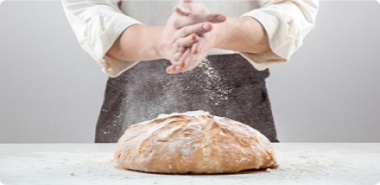Abstract: For baking purposes of the food additive is "angel." Fresh-baked bread looks fluffy but tastes chewiness, which is the credit for strong gluten agent and bread improver. Bread, nice color, can not be separated from the pigment; smell fragrant, is the role of flavor.The chemical additives in bread is not always the "sweet poison" in general regular bread production, food additives, including oxidants, emulsifiers, enzymes, mildew, etc.These food additives in accordance with the standard amount to add, it is safe to human body.
Keywords: Food ingredient bread additive cheap emulsifiers prolong shelf life of product
1.Additives in breadmaking
I guess you all love fluffy and soft bread that everyone can't resist. The store that sells the bread knows your preferences, so add some magic to make it tender and soft.That's the wonder of food additives and baking pairings! The right amount of additives can make our bread full of flavor, and the texture of the dough is silky and clear. Under high temperature baking, the expanded dough makes the dough larger.The appearance, quality and taste of bread are inseparable from the choice of emulsifier. Choosing the most potent emulsifier is the focus of manufacturers.The most commonly used additives are:emulsifier, thickener,
Antioxidant, enzyme, preservative,leavening agent, etc.
1.1.Application of Emulsifier in Bread
Most of the starch in fresh bread has been converted from β-starch to α-starch during the baking process. However, during the storage process, the starch has the opportunity to rearrange, and most of the α-starch gradually returns to the β-starch structure state, which makes the bread dry, dull, and "aged". The emulsifier can block and delay the rearrangement of starch, thereby preventing and delaying the "aging" of the bread, keeping the bread soft and elastic. It can be seen that the emulsifier mainly has the effect of emulsifying and preventing starch aging. In addition, the emulsifier in bread production can also improve the structure of gluten, so that the bread volume increases, the moisture content is high, the taste is good, the shape is good, and the shelf life of the bread is prolonged.
1.1.1.DATEM(Diacetyl Tartaric Acid Esters of Mono-and Diglycerides)
DATEM has strong emulsifying, dispersing and anti-aging effects, and is a good emulsifier and dispersant. It can effectively enhance the elasticity, toughness and air retention of the dough, and reduce the weakening of the dough. Increase the volume of bread and steamed buns and improve the organizational structure.
1.1.2.DMG(Distilled Monoglyceride)
Distilled Monoglyceride has the functions of emulsifying and dispersing and thickening and stabilizing. The application of monoglycerides in bread production can prevent bread from aging and hardening, and prolong the fresh-keeping period of bread. It has the functions of emulsifying, dispersing, stabilizing, foaming and anti-starch aging.
1.1.3.Soy Lecithin
Soybean lecithin is a natural and excellent surfactant, which is beneficial to the uniformity and stability of stirring and mixing of raw materials. The lecithin contained in it contains more hydrophilic groups in its structure, and it swells into a smooth milky substance when exposed to water. When baking, the protein expands into a foam, so that the central layer structure forms a porous sponge-like loose body , which in turn leads to an increase in product volume and finer pores. In addition, because soybean lecithin contains cephalin, it has antioxidant effect, which can prevent the aging of bread and prolong the fresh-keeping period of bread.
1.1.4.Polyglyceride
After adding polyglycerol ester, it can effectively improve the texture structure of bread or biscuit, prevent oil leakage and improve product quality. It can also be formulated as a cake foaming agent to help stir and foam, produce cakes and pastries with fine structure and significantly increased volume, and prolong the shelf life of products. For example, ten-polyglycerol monolaurate has anti-aging effect on starch, improves the processing quality of bread and snack foods, reduces starch viscosity and improves impact resistance; increases the amount of air in the process of dough proofing and batter preparation, so that pores Homogeneous, increasing the baking volume while dispersing grease, water and sugar more evenly in the dough, making the bread fluffy and improving its flavor and chewiness. Research continues on the role of polyglycerol esters in these starchy foods.
1.2.Antioxidants
Refers to the substances that can prevent or delay the oxidation of food, improve the stability of food and prolong the storage period. Such antioxidants include
* Ascorbic acid and its derivatives
* Sulfites
Since sulfites, ascorbic acid and their derivatives have the activities of consuming oxygen and inhibiting polyphenol oxidase at the same time, they are often used as color-preserving agents in fruit and vegetable products.
1.3.Enzymes
The enzyme preparation used in bread production is mainly amylase. Generally, β-amylase in flour is relatively sufficient, but the content of α-amylase is very small. Adding an appropriate amount of α-amylase changes the gelatinity of colloidal starch, so that the elasticity of each small air cell in the bread is enhanced and swelled, thereby increasing the Bread volume, improve internal organization, and can slow down the aging retrogradation of starch, keep bread soft.
1.4.Preservative
1.4.1.Calcium propionate
Calcium propionate can effectively inhibit filamentous bacteria, aerobic bacteria, bacilli, prevent bread from sticking, and is harmless to yeast, so it is often used as a bread preservative to prevent bread from going mouldy, but it has limited effect on bacteria, and is harmful to yeast and yeast. Anaerobic bacteria have no inhibitory ability.
1.4.2.Sodium dehydroacetate
Sodium dehydroacetate can be used in a wide range, it can inhibit the growth of bacteria, yeast, mold, Escherichia coli and other microorganisms, and the antibacterial effect is not affected by the pH of the food, nor is it affected by heating, it has high relative stability, and is especially suitable for Used in bakery and other foods.
Generally, commercial bread will start to mold after three days at 25°C and relative humidity of 70-90%. If sodium dehydroacetate is used to make bread, it should be added after the flour is fermented (added before the flour is fermented, which will affect the fermentation). Dissolve it with water and add it with the ingredients, and then bake it. The dosage can be 0.01%, and it will not get moldy after being placed for 6 days. If the concentration is increased to 0.03%, the mildew-proof time can be extended. The bread tastes pure and has no bad taste.
1.5.Leavening agent
1.5.1.Maltodextrin
Maltodextrin is made from various starches as raw materials, which are hydrolyzed, converted, purified and dried by enzymatic process to a low degree. The raw materials are starchy corn, rice, etc. Maltodextrin is widely used in candy, malt milk, fruit tea, milk powder, ice cream, beverages, canned food and other foods. The product is crispy and delicious, with moderate sweetness, no teeth, no residue, few defective products, and shelf life. The period is also long.
For more information, welcome to bookmark our website: https://www.cnchemsino.com/
Contact us for price and details : info@cnchemsino.com









